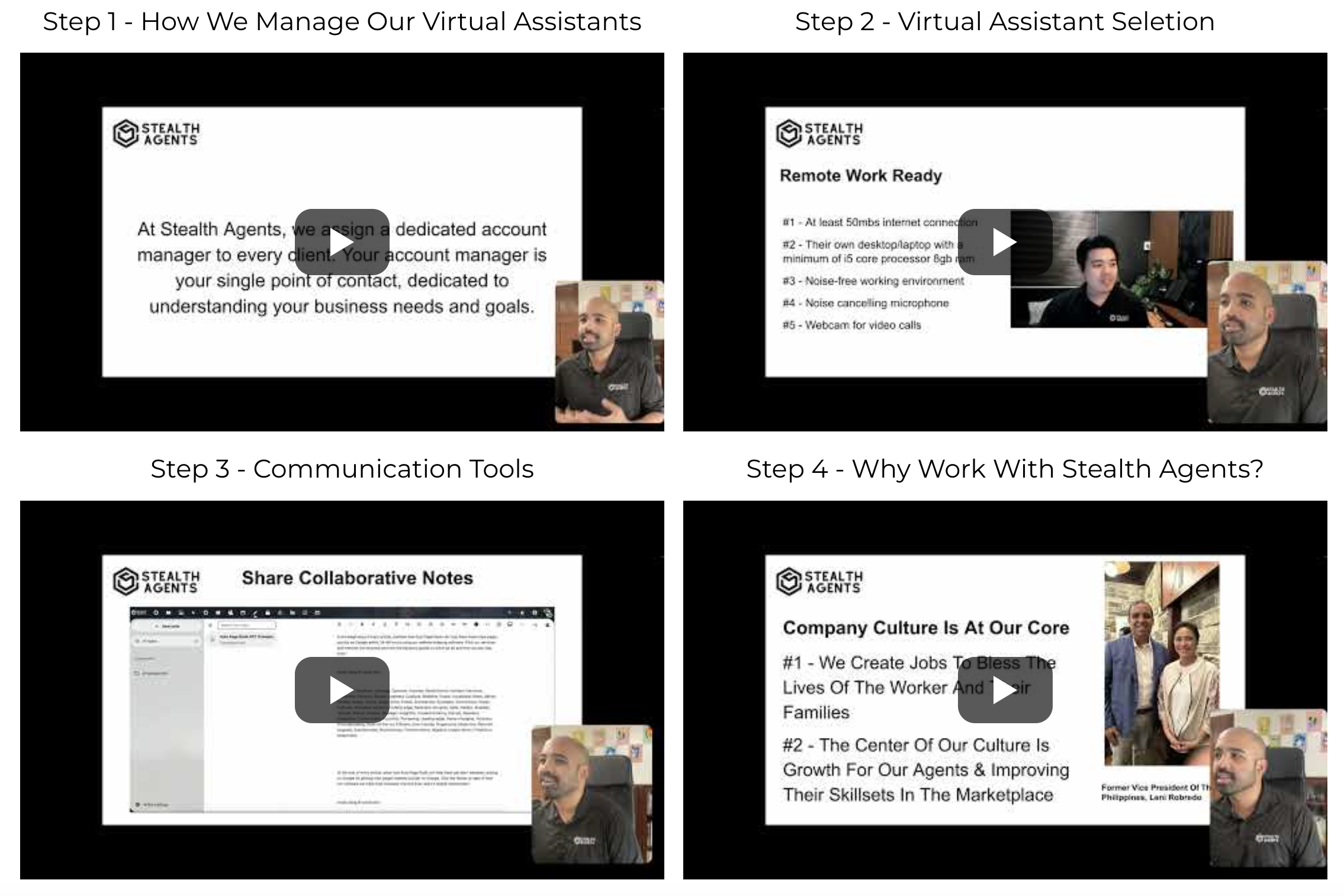Selecting the appropriate team collaboration and communication tools may have a big influence on productivity and creativity in today’s fast-paced work environment.
An interesting comparison of two potent systems that serve various organizational purposes is provided by Slack vs. Miro.
Slack is renowned for its robust messaging capabilities, offering seamless team communication and integration with various applications to streamline workflows.
On the other hand, Miro shines in the realm of visual collaboration, providing an interactive canvas for brainstorming, diagramming, and project planning.
It empowers teams to visualize ideas and collaborate in real time, making it an invaluable tool for creative sessions. Understanding these core differences is crucial for businesses to enhance their collaborative efforts.
Stealth Agents have meticulously created, curated, and compiled this resource to assist in this decision-making process, ensuring that it offers valuable insights to guide you in selecting the platform that best aligns with your team’s unique requirements.
What is Slack?
Slack is a versatile communication platform that facilitates seamless and efficient collaboration among team members.
It serves as a digital workspace where conversations are organized into channels, allowing teams to manage projects, share files, and integrate with various third-party applications.
Slack enhances team communication by providing real-time messaging, video calls, and notifications, ensuring everyone stays connected and informed.
Its robust search functionality allows users to easily find past conversations and files, making it a powerful tool for maintaining organizational knowledge.
Slack has grown in popularity as an option for businesses trying to enhance internal communication and teamwork by offering a flexible and intuitive interface.
Key Features:
- Channels: Channels in Slack allow teams to organize conversations by topics, projects, or departments, enabling easy access to relevant discussions and resources. This structure reduces email clutter and ensures team members can quickly find and participate in ongoing conversations.
- Integrations: Slack supports integration with over 2,000 apps, including Google Drive, Trello, and Zoom. Through these connections, users may improve process efficiency and access essential tools within the platform. They also enable teams to automate tasks and share information seamlessly across different applications.
- Direct Messaging: Slack provides direct messaging capabilities, allowing team members to communicate one-on-one or in small groups, ensuring privacy and focused discussions. This feature is ideal for quick questions, feedback, or discussions that don’t require the involvement of an entire channel.
- File Sharing and Storage: Users can easily direct file sharing between papers, photos, and other items within Slack with options to search and organize these files for easy retrieval. This feature simplifies collaboration by eliminating the need for external file-sharing services and keeping all resources accessible in one place.
- Search Functionality: Slack offers powerful search capabilities, enabling users to find messages, files, and links quickly, even in extensive conversation histories. This tool helps teams retrieve crucial information and maintain a comprehensive record of their communications.
Pros:
- Enhanced Communication: Slack improves team communication by providing a central hub for messages, files, and app integrations, keeping everyone connected and informed. Its real-time messaging and notifications ensure that team members are always up-to-date with the latest developments.
- User-Friendly Interface: The platform’s intuitive design makes it easy for users to navigate channels, find conversations, and manage notifications, promoting efficient collaboration. New users can quickly adapt to the interface, minimizing the learning curve and maximizing productivity.
- Customization: Slack offers extensive customization options, allowing teams to tailor notifications, themes, and integrations according to their preferences and workflow needs. This flexibility enables teams to create a communication environment that suits their unique requirements.
- Cross-Platform Availability: Slack is accessible on various devices, including desktops, smartphones, and tablets, ensuring that users can communicate and collaborate from anywhere. This cross-platform availability supports remote work and enhances connectivity for distributed teams.
- Community and Support: Slack has a large user community and extensive support resources, including tutorials, forums, and customer service. These help users troubleshoot issues and optimize their use of the platform. This network ensures that users can access valuable insights and assistance when needed.
Cons:
- Notification Overload: With numerous channels and integrations, users may experience notification overload, which can lead to distractions and reduced productivity. Managing notification settings effectively is essential to prevent this issue.
- Cost for Premium Features: While Slack offers a free version, access to advanced features and more extensive storage requires a subscription, which can be costly for some organizations. Teams must assess their needs to determine if the premium features justify the expense.
- Dependency on Internet Connectivity: Slack requires a stable internet connection as a cloud-based service, which can be a limitation for teams in areas with unreliable connectivity. Offline access to conversations and files is limited, potentially hindering collaboration during outages.
- Information Overload: With extensive conversations and files shared in Slack, users may need help keeping track of all information, leading to potential miscommunication. Using search and organization features effectively is crucial to manage this information efficiently.
- Learning Curve for Advanced Features: While the basic functionalities are user-friendly, some advanced features and integrations could have a higher learning curve and need more training for practical use. Teams may need to invest time in learning to maximize Slack’s capabilities.
What is Miro?
Miro is a dynamic online collaborative whiteboard platform that facilitates visual collaboration and brainstorming among teams.
It provides an interactive canvas where users can create, share, and organize ideas in real-time, making it an ideal tool for creative problem-solving phrases for business and project planning.
Miro supports various templates and tools for collaborative activities, such as mind mapping, flowcharting, and wireframing, to enhance team productivity and creativity.
Its real-time collaboration features let several people simultaneously work simultaneously, ensuring everyone is on the same page and contributing effectively.
By offering a versatile space for visual thinking, Miro is becoming a necessary tool for groups looking to innovate and streamline their workflows.
Key Features:
- Infinite Canvas: Miro provides an expansive, flexible space where teams can brainstorm, organize, and visualize their ideas without constraints. It accommodates complex projects and diverse workflows. The infinite canvas allows users to zoom in and out, providing a holistic view or focusing on specific details as needed.
- Templates and Tools: Offering a variety of pre-built templates and tools, Miro helps users quickly start projects like mind maps, customer journey maps, and Kanban boards, saving time and ensuring consistency. These resources are customizable, enabling teams to tailor them to their needs and processes.
- Real-Time Collaboration: Miro enables multiple users to collaborate simultaneously, with instant updates and feedback, fostering a more interactive and engaging working environment. This feature is crucial for remote teams, allowing them to work as if they are in the same room, regardless of geographical location.
- Integration Capabilities: The platform integrates with numerous applications, including Slack, Microsoft Teams, and Google Workspace, allowing seamless information sharing and enhancing productivity by connecting existing tools. These integrations help streamline workflows and ensure teams can access all necessary resources within one platform.
- Presentation Mode: Miro includes a presentation mode that allows users to showcase their boards in a structured, professional manner. This feature assists in conveying ideas clearly during meetings or workshops. It is particularly useful for stakeholder presentations and team reviews, providing a polished and organized view of collaborative efforts.
Pros:
- Visual Collaboration: Miro excels in supporting visual collaboration, making it easy for teams to brainstorm and organize ideas creatively, which enhances innovation and problem-solving. Its visual approach helps better understand and retain information, fostering effective team communication.
- User-Friendly Interface: The platform’s intuitive design ensures that users can quickly learn and navigate its features, minimizing the time spent on training and maximizing productivity. Its drag-and-drop functionality and clear layout make it accessible to users with varying technical expertise.
- Scalable for Different Use Cases: Miro is customizable and scalable, suitable for various team sizes and project types, from small startups to large enterprises, accommodating diverse collaborative needs. Its flexibility ensures that it can adapt to changing requirements as teams grow and projects evolve.
- Robust Community and Support: Miro boasts a strong community and extensive support resources, including tutorials, forums, and customer service. These aid users in troubleshooting and optimizing their experience. This support network ensures users can maximize the platform’s potential and overcome challenges.
- Cross-Platform Functionality: Available on desktop and mobile devices, Miro ensures that teams can collaborate from anywhere, supporting remote work and enhancing connectivity. This cross-platform functionality allows users to stay engaged and productive, regardless of location.
Cons:
- Complexity for New Users: While user-friendly, Miro’s vast array of features can overwhelm new users, requiring time to explore and understand its full capabilities. Initial training or guided tours may be necessary to help users effectively utilize the platform.
- Cost for Large Teams: While Miro offers a free version, larger teams may find the cost of premium features and additional users expensive, which can be a barrier for some organizations. Teams must evaluate whether the premium plan investment aligns with their budget and collaborative needs.
- Internet Dependency: As a cloud-based platform, Miro requires a stable internet connection, which can be a limitation in areas with unreliable connectivity, potentially impacting collaboration. Limited offline capabilities may hinder continuous work during internet outages.
- Feature Overload: Miro’s extensive tools and functionalities can sometimes lead to feature overload, making it difficult for teams to focus on essential tasks. Prioritizing and customizing features according to team needs is crucial to avoid distractions.
- Security Concerns: With sensitive information potentially shared on Miro, some users may have concerns about data security and privacy, especially in industries requiring strict compliance. Ensuring that security measures are in place and understanding the platform’s privacy policies are essential for peace of mind.
Slack vs Miro: Detailed Features Comparison
1. Communication and Messaging
In the Slack vs Miro comparison, Slack stands out as a robust messaging platform designed to streamline team communication.
It offers organized channels for different topics or projects, allowing users to manage discussions effectively. Team members can send direct messages, share files, and integrate various apps to enhance communication.
However, Miro is not primarily focused on messaging but facilitates communication through comment threads and annotations on its boards.
While Miro supports discussions around visual content, Slack provides a more comprehensive solution for day-to-day team communication.
2. Visual Collaboration
Miro excels in visual collaboration, offering an infinite canvas where teams can brainstorm, draw, and organize ideas in real-time.
It offers several tools and templates for creating diagrams, mind maps, and flowcharts, making it ideal for creative and strategic planning business.
On the other hand, Slack lacks these visual capabilities and focuses instead on text-based communication.
While Slack can integrate with Miro to bring visual elements into discussions, it cannot natively support Miro’s interactive visual collaboration.
In the Slack vs Miro comparison, Miro is the go-to for teams seeking rich, visual interaction.
3. Integrations and Compatibility
Slack vs Miro offer extensive integration options, enhancing their usability within existing workflows.
Slack integrates seamlessly with over 2,000 applications, including Google Drive, Trello, and Zoom, bringing all necessary tools into one cohesive platform for easy access.
Miro also supports integrations with popular apps like Microsoft Teams, Google Workspace, and Slack, allowing smooth transitions between visual collaboration and communication.
In the Slack vs Miro landscape, both platforms provide strong integration capabilities, with Slack focusing on communication tools and Miro on visual collaboration applications.
4. Collaboration in Real-Time
Real-time collaboration is a highlight in Slack vs Miro, but their approaches differ. Slack offers real-time messaging and notifications, ensuring instant communication among team members.
Conversely, Miro allows multiple users to interact on the same board simultaneously, providing instant updates and customer feedback loops on visual projects.
While Slack facilitates immediate exchanges of ideas through text, Miro supports real-time visual engagement, enabling teams to collaborate as if they are in the same room.
Both platforms enhance teamwork, but Miro offers a more immersive visual collaboration experience.
5. User Experience and Interface
When comparing Slack vs Miro regarding user experience, both platforms provide intuitive interfaces tailored to their specific functions.
Slack features a user-friendly design that organizes conversations into channels, making navigation straightforward for team communication.
Miro’s interface supports drag-and-drop functionality and offers an expansive canvas for visual projects, catering to users who prefer a more interactive workspace.
While Slack is optimized for efficient communication, Miro prioritizes ease of use for visual collaborations.
The choice between Slack vs Miro often depends on whether a team needs a text-based communication hub or a visual collaboration platform.
How do Stealth Agents Choose Slack vs Miro?
When Stealth Agents choose between Slack vs Miro, they meticulously evaluate each platform based on specific criteria that align with their operational needs.
First and foremost, they assess their team’s communication requirements, considering whether streamlined messaging is more critical than visual collaboration.
Slack often becomes the preferred choice for projects that demand constant, real-time text communication and integration with other top productivity tools for remote work.
On the other hand, when visual brainstorming and interactive planning are essential, Miro’s expansive canvas and creative tools prove invaluable.
Integration capabilities are another vital factor, as they ensure seamless workflow processes; both platforms offer robust integrations, but the choice hinges on which team most frequently uses apps.
User experience also plays a significant role, with Stealth Agents weighing each tool’s ease of navigation and learning curve against their team’s technical proficiency.
Finally, they evaluate the strengths and weaknesses of Slack vs Miro in the context of specific projects, ensuring that the selected platform enhances productivity and aligns with their strategic goals.
Through this comprehensive analysis, Stealth Agents can effectively decide whether Slack or Miro best suits their diverse and dynamic workflow needs.
Stealth Agents stands ready to assist if you are also looking for a virtual assistant. Book a free discussion to tailor preferences and explore virtual assistant pricing options.
Conclusion
In conclusion, the choice between Slack vs Miro mostly depends on your team’s unique requirements and the nature of your projects.
Slack facilitates seamless communication with its robust messaging attributes that make it the perfect option for groups prioritizing real-time interaction and integration with various productivity tools.
On the other hand, Miro shines in environments where visual collaboration is vital, offering an expansive canvas and creative tools for brainstorming and planning.
Understanding your team’s unique requirements—whether the need for efficient communication or creative outsourced data visualization—is crucial in making an informed decision.
Ultimately, both platforms offer distinct advantages, and aligning their strengths with your team’s workflow will ensure enhanced productivity and collaboration.













